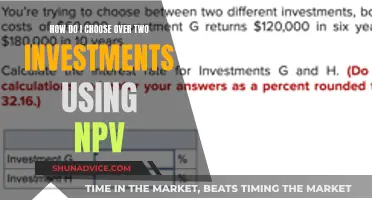
Robinhood is a commission-free trading platform that allows users to invest in everything from exchange-traded funds (ETFs) to Dogecoin without going through a traditional brokerage. It is a favourite among everyday traders who congregate in online forums like Reddit's r/WallStreetBets, with around 11.4 million monthly active users. The app is popular among young, first-time investors and has been criticised for making investing akin to a game. However, if you do some proper research, Robinhood can serve as a good introduction to investing. Here's how to get started:
- Figure out your motivation for investing. Are you doing this to make some quick cash, or because you want to put your money to work responsibly and are prepared to think about long-term strategies?
- Make sure you've paid off all your credit card and high-rate consumer debt. Contribute enough to your employer-sponsored plan to maximise any potential match benefit.
- Set some investing goals. For example, you may want to invest to help pay for a new couch, a trip, an engagement ring, or a down payment on a future home.
- If you're new to investing, start with a small amount of money you're okay with losing and stick to stocks and ETFs.
- Create a diversified portfolio with at least fifteen stocks across different industries and company sizes that you've already done your due diligence on.
- Get familiar with investing news sites and content from verified financial planners.
- Use a stock market simulator to create a practice portfolio, which will help you learn how the market fluctuates over time and how to develop healthy investing habits.
| Characteristics | Values |
|---|---|
| Account opening requirements | 18 years or older, valid Social Security number, and a U.S. address |
| Investment options | Stocks, bonds, ETFs, crypto, fine arts, royalties, luxury goods, U.S. Treasuries, fractional shares |
| Fees | $0 commission charge on stocks & ETFs, $0 equity options contracts fee, 6.8% margin rate |
| Minimum investment | Start investing with as little as $1 |
| Additional features | 24-hour market, dividend reinvestment, recurring investments, access to financial planners |
What You'll Learn

Understand the basics of investing with stocks
Before you begin investing, it's important to understand what stocks are and how they work. Stocks are units of ownership in a company. If you own a stock, you become a shareholder, and may be eligible to receive dividends if the company is successful. You may also get a vote in some company decisions.
The stock market is a platform that connects stock buyers and sellers, allowing them to trade under an agreed-upon set of rules. When you invest in the stock market, you're essentially buying ownership stakes in different companies, with the expectation of future income or profit.
Investing requires time and patience, and it's important to have clear goals and do your research before starting. Reflect on your current financial situation and your future aspirations. It's also crucial to pay off any high-interest debt and create an emergency fund before investing.
When picking stocks to invest in, consider your personal needs, style, and objectives. Compare different companies and make decisions based on key metrics and your own risk tolerance. Diversifying your portfolio by spreading your investments across different assets can help reduce the risk of losses.
Additionally, it's important to understand the different types of orders when buying stocks. During regular market hours, dollar-based buy orders are usually market orders, while share-based buy orders are limit orders with a preset price. Outside of regular market hours, both dollar-based and share-based buy orders are typically placed as limit orders.
Finally, remember that investing comes with inherent risks, and there are no guarantees of future performance. Always do your own research and make informed decisions based on your financial situation and goals.
Maximizing Your Spare Cash: Smart Investing Strategies
You may want to see also

Open an account and fund it
To start investing with Robinhood, you'll first need to open an account. To do this, you must be 18 years or older, have a valid Social Security number and a U.S. address. You can then download the app and put in your bank's routing number and account number. You'll also need to scan in your valid ID and take a photo of yourself through the app.
Once your account is open, you can transfer money from your bank to Robinhood to start investing. You can also set up recurring investments starting at $5 and auto-invest your spare change with every purchase.
If you're new to investing, it's recommended to start with a small amount of money that you're okay with losing and stick to stocks and ETFs. You can start investing with just a few dollars by buying fractional shares.
It's also important to do your research before investing. Familiarize yourself with investing news sites and content from verified financial planners. You can also use a stock market simulator to create a "practice portfolio" to help you understand how the market works and develop healthy investing habits.
Non-Cash Investing: Where to Disclose?
You may want to see also

Research and analyse stocks
Researching and analysing stocks is a crucial step in making informed investment decisions. Here are some detailed instructions on how to research and analyse stocks using Robinhood:
Go in with a plan:
Understand your personal investment goals and risk tolerance. Consider your investment horizon and the amount of risk you are willing to take. Assess how stock investments fit into your overall financial plan and portfolio allocation.
Know the different types of stocks:
Evaluate the size, sector, style, and dividend policy of the stocks you are considering. Look at the market capitalisation, the industry the company operates in, its growth prospects or value, and whether it pays dividends.
Check the fundamentals:
Analyse the financial health and performance of publicly traded companies. Review their financial statements, revenue growth, earnings per share, price-to-earnings ratio, debt-to-equity ratio, and other key financial metrics. This information is usually available on the SEC's EDGAR database or the companies' investor relations pages.
Utilise technical analysis:
Use charts and technical indicators to study price movements, volume, and other data. Robinhood offers various technical indicators such as Exponential Moving Average (EMA), Relative Strength Index (RSI), Moving Average Convergence Divergence (MACD), Volume-weighted Average Price (VWAP), and Bollinger Bands (BOLL).
Stay informed:
Keep yourself updated on the latest news and analyst ratings for the stocks you are interested in. Robinhood provides access to analyst research and ratings, as well as recent news articles about companies and their stocks.
Compare and track:
Compare the performance of different stocks within the same sector or industry. Track the stock's value over time using Robinhood's charts, which allow you to select different time intervals, from 1 day up to 5-year intervals.
Consider third-party research:
Robinhood Gold subscribers have access to professional research from Morningstar, providing in-depth stock research reports and analysis on companies' business strategies, economic moats, fair market value, risks, and leadership.
Remember, investing carries risks, and past performance does not guarantee future results. Always conduct thorough research and analysis before making any investment decisions.
Fidelity Branches: Can You Deposit Cash?
You may want to see also

Diversify your portfolio
Diversifying your portfolio is a critical step in reaching your long-term investment goals. It is the act of splitting your portfolio up into different types of investments, which helps to spread the risk. Here are some ways to diversify your portfolio using Robinhood:
Spread the Wealth
Do not put all your money into one stock or one sector. Consider creating your own virtual mutual fund by investing in a handful of companies you know, trust, and even use in your day-to-day life. You can also invest in commodities, exchange-traded funds (ETFs), and real estate investment trusts (REITs). Think beyond your home country and invest globally to spread your risk and potentially achieve bigger rewards.
Consider Index or Bond Funds
You may want to consider adding index funds or fixed-income funds to your portfolio. Investing in securities that track various indexes is a wonderful long-term diversification investment. By adding some fixed-income solutions, you further hedge your portfolio against market volatility and uncertainty. Index funds often come with low fees, which means more money in your pocket.
Keep Building Your Portfolio
Add to your investments on a regular basis. If you have a large sum of money to invest, use dollar-cost averaging to smooth out the peaks and valleys created by market volatility. This strategy involves investing the same amount of money over a period of time, reducing your investment risk.
Know When to Get Out
While buying and holding, and dollar-cost averaging are sound strategies, it is important to stay current with your investments and any changes in overall market conditions. This will help you know when it is time to cut your losses, sell, and move on to your next investment.
Keep an Eye on Commissions
If you are not a frequent trader, understand what you are getting for the fees you are paying. Some firms charge a monthly fee, while others charge transactional fees. Be aware of what you are paying and what you are getting for it, and keep yourself updated on any changes to your fees.
Diversification Strategies on Robinhood
Robinhood offers several aggressive investing strategies to help boost returns, including options, margin investing, and investing in cryptocurrencies. You can also invest in foreign stocks through American depositary receipts (ADRs) or ETFs, and gold through the SPDR Gold Trust ETF. Additionally, Robinhood has a robust app for cryptocurrencies, with an easy-to-use interface and no fees or transaction costs.
Moomoo Investment's Apex Clearinghouse: What You Need to Know
You may want to see also

Make your first trade
Making your first trade on Robinhood is a straightforward process. Here's a step-by-step guide to help you get started:
- Download the Robinhood App: Visit your device's app store (Apple App Store or Google Play Store for Android) and search for "Robinhood." The app is free and quick to install.
- Create Your Account: Sign up by providing basic personal information, including your name, email address, phone number, and Social Security number for tax purposes. You'll also need to create a secure password. Take note that you must be 18 years or older to use Robinhood.
- Link Your Bank Account: Before you start trading, connect your Robinhood account to a valid bank account or debit card. This is where you'll transfer funds to invest in the market. The app provides a simple and secure way to do this.
- Understand the Interface: The Robinhood app has an intuitive interface. You'll see your portfolio value, a news feed of market updates, and quick links to start trading. The bottom navigation bar allows you to access your portfolio, news feed, account overview, and more.
- Tap the Trade Button: When you're ready to make your first trade, tap the "Trade" button. You can use the search bar to find a specific stock ticker symbol, ETF, or cryptocurrency. Alternatively, you can browse trending stocks and funds.
- Choose Order Type: Decide between a market order, which executes immediately at the current market price, or a limit order, which only executes when the price reaches your specified target. Limit orders are useful if you want to buy at a lower price or sell at a higher price.
- Enter Share Quantity: Determine how many shares you want to purchase or sell. You can invest in fractional shares if you don't want to buy in full share increments.
- Review and Confirm: Carefully review the order preview, ensuring that the order type and share quantity are correct. Then, swipe to confirm your trade.
- View Trade Details: After executing your order, you'll receive a notification. You can view the trade details, including the purchase price, order type, share quantity, and total investment amount.
- Set Price Alerts: If you want to stay updated on your investments, set up customized price alerts. These alerts will notify you when a stock or cryptocurrency reaches a certain price threshold, helping you identify buying or selling opportunities.
Remember to do your research and understand the risks involved before placing your first trade. Additionally, consider starting with a small amount of money you're comfortable losing, especially if you're new to investing.
Cash or Invest: Where Should Your Money Go?
You may want to see also
Frequently asked questions
To get started with investing on Robinhood, you need to be 18 years or older, have a valid Social Security number and a U.S. address. You can then open an account and start investing with as little as $1.
Robinhood offers commission-free stock and ETF trades. You can also invest in alternative assets such as fine arts, royalties and luxury goods.
To buy stocks on Robinhood, you need to go to the stock's detail page and review its historical performance, analyst ratings, company earnings, and other information. You can then select "Trade → Buy" or simply "Buy" if you don't currently own the stock. You will then be asked to enter the amount you would like to purchase in dollars or shares. After reviewing and confirming your order, you can submit it.
Before investing on Robinhood, it is important to understand your motivation. Are you investing to make quick cash or as part of a long-term financial strategy? It is also crucial to ensure you have paid off any credit card and high-rate consumer debt, and are contributing enough to your employer-sponsored retirement plan. Additionally, setting clear investing goals and understanding the risks involved is essential.







